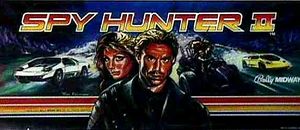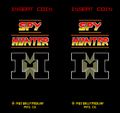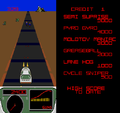Namcorules (talk | contribs) (Corrected "followed by" parameter in infobox per series template update) |
Namcorules (talk | contribs) (Added {{redirect disambig}} because of Spy Hunter 2 (2003)) |
||
| Line 14: | Line 14: | ||
|series=Spy Hunter | |series=Spy Hunter | ||
}} | }} | ||
{{redirect disambig|Spy Hunter 2|the [[2003]] [[Sony PlayStation 2]] and [[Microsoft Xbox]] game|[[Spy Hunter 2 (2003)]]}} | |||
{{marquee|Spy Hunter II marquee.jpg}} | {{marquee|Spy Hunter II marquee.jpg}} | ||
'''Spy Hunter II''' is a {{c|racing}}/[[shooter]] arcade game that was released by [[Bally Midway]] in [[1987]]; it runs on the company's MCR-68 hardware, and as the naming suggests, it is the sequel to [[Spy Hunter]], which was released four years earlier. Though it introduced the ability to allow two players to play the game simultaneously, it employed a three-point perspective which was reminiscent of that of Midway's own [[Max RPM]], and a two-person view (the cabinet had a bezel that divided the monitor into two halves) - and neither of these were popular with fans of the original, even though they made it more "realistic". | '''Spy Hunter II''' is a {{c|racing}}/[[shooter]] arcade game that was released by [[Bally Midway]] in [[1987]]; it runs on the company's MCR-68 hardware, and as the naming suggests, it is the sequel to [[Spy Hunter]], which was released four years earlier. Though it introduced the ability to allow two players to play the game simultaneously, it employed a three-point perspective which was reminiscent of that of Midway's own [[Max RPM]], and a two-person view (the cabinet had a bezel that divided the monitor into two halves) - and neither of these were popular with fans of the original, even though they made it more "realistic". | ||
Revision as of 12:00, 27 January 2022
- "Spy Hunter 2" redirects here. For the 2003 Sony PlayStation 2 and Microsoft Xbox game, see Spy Hunter 2 (2003).
Spy Hunter II is a racing/shooter arcade game that was released by Bally Midway in 1987; it runs on the company's MCR-68 hardware, and as the naming suggests, it is the sequel to Spy Hunter, which was released four years earlier. Though it introduced the ability to allow two players to play the game simultaneously, it employed a three-point perspective which was reminiscent of that of Midway's own Max RPM, and a two-person view (the cabinet had a bezel that divided the monitor into two halves) - and neither of these were popular with fans of the original, even though they made it more "realistic".
The first player will control a white car, while the second player will control a yellow one; both players' scores shall be displayed (at the bottoms of their respective halves of the screen), and there is also a Battlezone-style radar for both players, that shows the positions of any enemies in the vicinity of their cars, as well as a heads-up display, that displays their speeds and any weapons they have on board.
-
Title screen.
-
Upright arcade cabinet.
-
Screenshot of the game.



